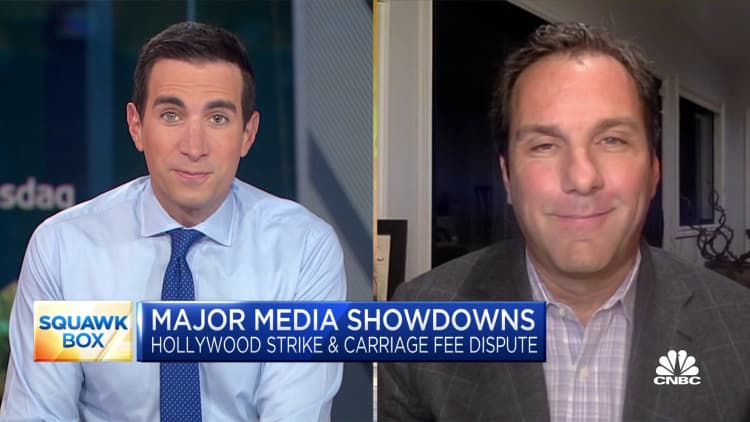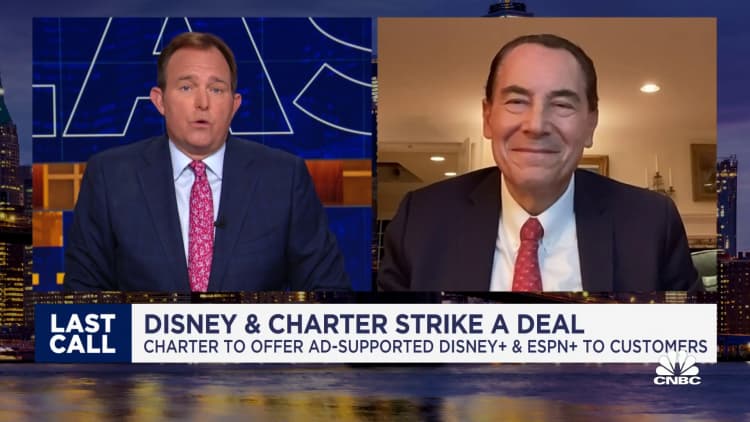[ad_1]
People carry signs as SAG-AFTRA members walk the picket line in solidarity with striking WGA workers outside Netflix offices in Los Angeles, July 11, 2023.
Mario Tama | Getty Images News | Getty Images
Picket signs have lined the gates of Hollywood’s studios for nearly five months, as the industry’s writers and actors rally for AI protections, better wages and a cut of streaming profits.
The problem is streaming isn’t yet profitable for many studios.
Sparked by the creation of Netflix’s direct-to-consumer platform in 2007, streaming has upended the economics of the media industry. Yet, it’s still unclear whether it’s a sustainable business model for the future.
“Without sounding hyperbolic, the change in the economics of the North American media industry in the last five years has been breathtaking,” said Steven Schiffman, an adjunct professor at Georgetown University.
Legacy media companies like Disney, Warner Bros. Discovery, Paramount and NBCUniversal scrambled to compete with Netflix when it began creating original content in 2013 and slowly pulled market share over the next five years. The studios padded their platforms with massive content libraries and the promise of new original shows and films for consumers.
However, the subscription-based streaming model proves vastly different than the ad-revenue-fueled traditional TV bundle. High licensing costs and low revenues per subscriber quickly caught up with studios, which had previously placated shareholders with massive subscription growth.
Netflix was the first streamer to report a loss in subscribers in 2022, sending its stock and other media companies spiraling. Disney has followed suit. Since then, both have set subscription numbers aside in favor of advertising, a password-sharing crackdown and raising prices.
Media companies also have begun slashing content spending budgets. Disney CEO Bob Iger has promised the company will focus on quality over quantity when it comes to both its streaming and theatrical businesses, pointing to Marvel as an example of too much content.
Yet streaming remains the focus for all of these companies as consumers rapidly cut the cord and opt for streaming. To make up for the losses, media organizations are now relying on methods that once made the traditional bundle so successful.
“What’s the fundamental solution? In some way, shape or form, it’s everything brought together,” said CEO Ken Solomon of the Tennis Channel, owned by Sinclair, of the various business models in media. “It’s about understanding where to put a little more resources and how they all are glued together to satisfy the consumer.”
A broken model
Two strategies media companies long relied upon — windowing content to various platforms and creating more cable channels to reap higher fees from the bundle — proved lucrative and still reap profits.
“This gun has been cocking itself for decades,” said Solomon, noting that the pay TV bundle was a good value proposition until it became too expensive for consumers. That gave Netflix an opening to upend how the entertainment industry makes and spends money.
Legacy media companies scrambled to follow suit, unsure if the model actually worked. But they were desperate to keep up with changing consumer demand, and in the process they depleted other revenue streams.
Now turmoil rules the industry. Companies like Disney and Warner Bros. Discovery are in the midst of reorganizations — slashing jobs and content costs while trying various ways to piece together profits.
An image from Netflix’s “Stranger Things.”
Source: Netflix
“All of these companies spent more money than they likely should have,” said Marc DeBevoise, CEO and board director of Brightcove, a streaming technology company.
Netflix, with a considerable head start, is the only company to make a profit off of streaming. “For everyone else, it’s still dictated by linear TV,” said UBS analyst John Hodulik. “That’s a problem as the decline in customers accelerates and streaming is not a big enough opportunity to offset that.”
Although subscriber growth initially ramped up streaming subscriber growth and bolstered many media stocks, it was short-lived. Fears of a recession, inflation and rising interest rates led Wall Street to reassess these companies and focus on profitability as subscriber growth slowed.
A content arms race
Netflix’s entrance into media signaled the beginning of a content arms race that, ultimately, hasn’t paid off for any media company.
Content spending ballooned across the industry, with each company spending tens of billions of dollars for new shows and films in an effort to lure in new subscribers — and keep the ones they already had.
“The networks had aligned with their streaming services and taken all the elasticity out of it. They were throwing money at a problem and hoping that it was going to solve itself,” said Solomon. “There was no economics behind it.”
Race to launch
- Netflix — launched streaming service in January 2007, first original content launched February 2013
- Hulu — launched streaming service in March 2008
- Paramount+ — launched as CBS All Access in October 2014, rebranded as Paramount+ in March 2021
- Disney+ — launched streaming service in November 2019
- Peacock — launched streaming service in April 2020
- Max — launched as HBO Max in May 2020, rebranded as Max in May 2023
There were also massive one-off licensing deals for shows like “The Office,” “Friends” and “Seinfeld,” which viewers were actively watching on repeat.
Studios even struck exclusive contracts with some of Hollywood’s biggest writer-producers — Ryan Murphy, Shonda Rhimes, J.J. Abrams, Kenya Barris and the duo of David Benioff and D.B. Weiss — in the hope that they could create new projects that could capture the attention of audiences.
Show budgets draw a lot of attention these days. But Jonathan Miller, a former Hulu board member and current CEO of Integrated Media, doesn’t recall that being a focus when it was just the four major broadcast networks creating all of the content.
DeBevoise, a former ViacomCBS (now Paramount) executive, said he doesn’t remember greenlighting a show, including “Star Trek Discovery,” in the mid-2010s at CBS for more than $10 million an episode, noting many were “much, much less expensive.”
Meanwhile, Solomon, who once ran Universal Studios Television, recalled when his budgets for top TV shows like “Law & Order” were below $2 million an episode. “I thought budgets were out of control back then,” he said.
Shonda Rhimes attends 2018 Vanity Fair Oscar Party on March 4, 2018 in Beverly Hills, CA.
Presley Ann | Patrick McMullan | Getty Images
Disney sought to capitalize on the success of its Marvel Cinematic Universe by developing more than a dozen superhero shows for its Disney+ platform. Although the seasons were shortened, often only six to 10 episodes, each episode cost around $25 million. Similar production budgets were seen for the company’s foray into the new live-action Star Wars TV series.
Netflix has poured money into multiple seasons of political drama “The Crown,” science fiction darling “Stranger Things” and a series based on The Witcher video game franchise. Production costs per episode for these series ranged from $11 million to $30 million.
And Warner Bros. Discovery is adding more Game of Thrones series to its catalog of direct-to-consumer offerings with “House of the Dragon,” which cost around $20 million per episode, and the upcoming “A Knight of the Seven Kingdoms: The Hedge Knight,” which has not begun filming.
Meanwhile, e-commerce giant Amazon shelled out a record $465 million on its first season of a Lord of the Rings prequel series, which was met with tepid responses from critics and fans alike.
“The price of content isn’t always determinant of success. ‘The Simpsons’ were crudely animated initially, right? So, it’s not necessarily that if you go spend a lot of money, it works,” Solomon said.
Bart Simpson plays esports in an episode of “The Simpsons” that aired on March 17, 2019.
Fox
At the same time the economics for actors, writers and the industry as a whole changed.
“The problem is that the cost increases don’t make sense given the revenue models. Something got broken in this part of the business if that kind of increase happened and actors and writers don’t feel like they got their fair share,” DeBevoise said.
A growing disconnect
While many of Hollywood’s biggest studios are publicly traded and must share quarterly financial reports, there are no rules about providing streaming-viewership data. This lack of transparency has made recent contract negotiations between studios and the industry’s writers and actors especially contentious.
“There’s a frustration about how these people can get together and share this information and come up with something that is reasonable for both sides,” said Schiffman, the Georgetown professor. “But until that happens, in my view, this thing goes on until next year.”
Streaming studios, in particular, have long been reluctant to share data around viewership and don’t want compensation to be tied to the popularity of shows, including those that have been licensed from other studios.

This is in stark contrast to how linear television has handled popular shows. Traditionally, studios pay residuals, long-term payments, to those who worked on film and television shows after their initial release. Actors and writers get paid every time an episode or film runs on broadcast or cable television or when someone buys a DVD or Blu-ray Disc.
When it comes to streaming, there are no residual payments. Studios that get a licensing fee pass on a small sum to actors and writers, but no additional compensation is given if the show performs well on the platform. Actors, in particular, are looking to change this.
“Why I think the streaming model has been a difficult model for the actors and writers, and I was part of helping that model, is that there was a fundamental shift of long-term versus short-term economics that likely wasn’t properly understood or explained,” said DeBevoise.
Back to the future
Media companies’ effort to make streaming profitable is drawing out many of the old business models that were successful in the past.
The subscription streaming model is being subsidized now by tried and true models like advertising, licensing content to other platforms, cracking down on password sharing, and windowing content to different platforms with longer stretches of time in between.
“Netflix understood finally, because of the Street, that subscriber numbers don’t mean jack, if the economics don’t pencil out,” said Peter Csathy, founder and chair of advisory firm Creative Media.
Even the pay TV bundle, despite rampant cord cutting by consumers, remains a reliable source of revenue.

“We, the distributors, are funding the streaming experience. And it’s frankly a better content experience on streaming than what is provided to us on linear TV,” said Rob Thun, chief content officer at DirecTV. “These companies will cease to exist without the funding of distributors’ licensing fees. Perhaps this is a moment of awakening.”
Disney and even Netflix, which long resisted ads, are among the companies relying more on ad-supported offerings to boost subscriber growth and bring in another revenue stream, even as the ad market has been soft.
This is especially true as free, ad-supported streaming services like Fox Corp.’s Tubi and Paramount’s Pluto — which are likened to broadcast networks — have also exploded. Besides the parent companies leaning on the ad revenue from these platforms, other media companies, like Warner Bros. Discovery, are funneling content there for licensing fees.
“In terms of the business models, they all ‘work,'” said DeBevoise. He noted paid tiers for the more expensive, timely content will remain, while free and options with commercials will support the older library shows and movie. “There are going to be hybrid models that reincarnate the dual-revenue cable TV model with both a subscription fee and ads. It’s all going to be about price-to-value and time-to-value for the consumer.”
Disclosure: Comcast is the parent company of NBCUniversal and CNBC.
[ad_2]

